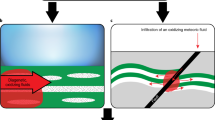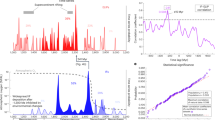Abstract
LATEST Archaean and earliest Palaeoproterozoic times (from 2.6 to 2.2 billion years ago) have generally been viewed as a largely quiescent period of Earth history; the geological record indicates the very slow deposition of pelagic and chemical sediments1,2, and bears only a limited record of magmatic and tectonic activity3–5. Such quiescence is consistent with the contention that the Earth's main banded iron formations (BIFs)—finely laminated chemical sedimentary rocks, rich in iron oxide—formed slowly as oxygen abundances in the oceans gradually increased, thus reducing the capacity of sea water to retain dissolved iron6–10. Here we show that a large igneous province, comprising >30,000km3 of dolerite, basalt and rhyolite, accompanied deposition of a Hamersley Province BIF 2,449 ±3 million years ago. This observation indicates that Hamersley BIFs formed during a major tectono-magmatic event and were deposited very much faster than previously thought, at similar rates to (or faster than) modern pelagic sediments. Thus the largest Palaeoproterozoic BIFs, rather than simply reflecting a gradual increase in the oxygen content of the oceans during a period of tectonic quiescence, are more likely to have formed as a result of an increased supply of suboxic iron- and silica-rich sea water upwelling onto continental shelves during a pulse (or pulses) of increased submarine magmatic and hydrothermal activity.
This is a preview of subscription content, access via your institution
Access options
Subscribe to this journal
Receive 51 print issues and online access
$199.00 per year
only $3.90 per issue
Buy this article
- Purchase on Springer Link
- Instant access to full article PDF
Prices may be subject to local taxes which are calculated during checkout
Similar content being viewed by others
References
Arndt, N. T., Nelson, D. R., Compston, W., Trendall, A. F. & Thorne, A. M. Aust. J. Earth Sci. 38, 261–281 (1991).
Barton, E. S., Alterman, W., Williams, I. S. & Smith, C. B. Geology 22, 343–346 (1994).
Condie, K. C. in Archaean Crustal Evolution (ed. Condie, K. C.) 85–120 (Elsevier, Amsterdam, 1994).
Lowe, D. R. in The Proterozoic Biosphere; a Multidisciplinary Study (eds Schopf, J. W. & Klein, C.) 67–76 (Cambridge Univ. Press, 1992).
Windley, B. F. The Evolving Continents (Wiley, Chichester, 1995).
Cloud, P. Econ. Geol. 68, 1135–1143 (1973).
Holland, H. D. The Chemical Evolution of the Atmosphere and Oceans (Princeton Univ. Press, 1984).
Beukes, N. J. & Klein, C. in The Proterozoic Biosphere; a Multidisciplinary Study (eds Schopf, J. W. & Klein, C.) 146–151 (Cambridge Univ. Press, 1992).
Kasting, J. F. Precambr. Res. 34, 205–229 (1987).
Des Marais, D. J. Chem. Geol. 114, 303–314 (1994).
Blake, T. S. & Barley, M. E. Tectonics 11, 1415–1425 (1992).
Trendall, A. F. & Blockley, J. G. Bull. Geol. Surv. W. Aust. 119 (1970).
Morris, R. C. & Horwitz, R. C. Precambr. Res. 21, 273–297 (1983).
Isley, A. E. J. Geol. 103, 169–185 (1995).
Ohmoto, H. Geol. Soc. Aust. Abstr. 37, 324 (1994).
Tiara, A. et al. Geol. Soc. Aust. Abstr. 37, 426 (1994).
Morris, R. C. Precambr. Res. 60, 243–286 (1993).
Trendall, A. F. Econ. Geol. 68, 1089–1097 (1973).
Trendall, A. F. et al. 3rd Int. Archaean Symp. Abstr. 81–83 (Geoconferences, Perth, 1990).
Trendall, A. F. Rep. Geol. Surv. W. Aust. 42 (1995).
Davy, R. Recd. Geol. Surv. W. Aust. 1991/6 (1992).
Pankhurst, R. J. & Rapela, C. R. Earth Planet. Sci. Lett. 134, 23–36 (1995).
Storey, M. Nature 377, 301–308 (1995).
Compston, W., Williams, I. S. & Meyer, C. J. Geophys. Res. (Suppl.) 89, B525–B534 (1984).
Williams, I. S. & Claesson, S. Contrib. Mineral. Petrol. 97, 205–217 (1987).
Muller, P. J. & Mangini, A. Earth Planet. Sci. Lett. 51, 94–114 (1980).
McConchie, D. M. thesis, Univ. Western Australia (1984).
Nisbet, E. G. The Young Earth: an Introduction to Archaean Geology (Alien & Unwin, London, 1987).
Hamilton, P. J. J. Petrol. 18, 24–52 (1977).
Garzanti, E. Geology 21, 105–108 (1993).
Ewers, W. E. & Morris, R. C. Econ. Geol. 76, 1929–1953 (1981).
Author information
Authors and Affiliations
Rights and permissions
About this article
Cite this article
Barley, M., Pickard, A. & Sylvester, P. Emplacement of a large igneous province as a possible cause of banded iron formation 2.45 billion years ago. Nature 385, 55–58 (1997). https://doi.org/10.1038/385055a0
Received:
Accepted:
Issue Date:
DOI: https://doi.org/10.1038/385055a0
This article is cited by
-
Mechanisms and climatic-ecological effects of the Great Oxidation Event in the early Proterozoic
Science China Earth Sciences (2022)
-
Globally asynchronous sulphur isotope signals require re-definition of the Great Oxidation Event
Nature Communications (2018)
-
Modulation of oxygen production in Archaean oceans by episodes of Fe(II) toxicity
Nature Geoscience (2015)
-
Role of Ferrocyanides in the Prebiotic Synthesis of α-Amino Acids
Origins of Life and Evolution of Biospheres (2013)
-
Deposition of 1.88-billion-year-old iron formations as a consequence of rapid crustal growth
Nature (2012)
Comments
By submitting a comment you agree to abide by our Terms and Community Guidelines. If you find something abusive or that does not comply with our terms or guidelines please flag it as inappropriate.



